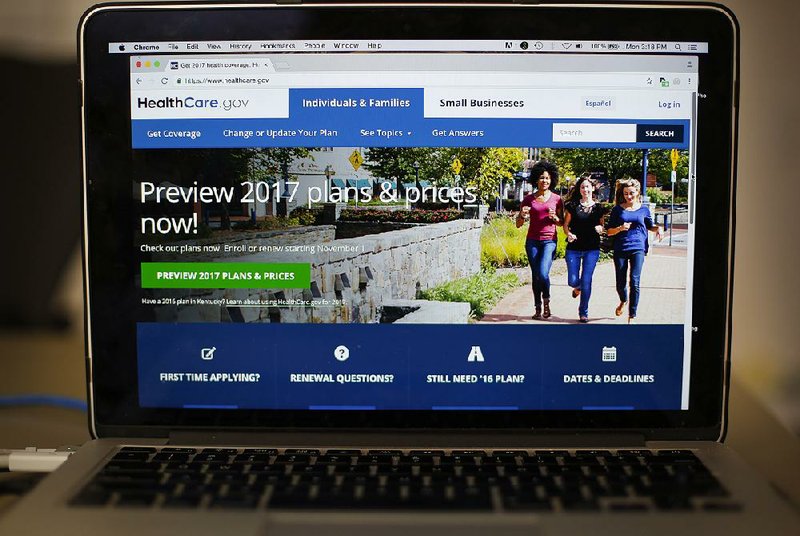WASHINGTON -- Premiums will go up sharply next year under President Barack Obama's health care law, and many consumers will be down to just one insurer, the administration confirmed Monday.
Before taxpayer-provided subsidies, premiums for a midlevel benchmark plan will increase an average of 25 percent across the 39 states served by the federally run online market, according to a report from the Department of Health and Human Services. Some states will see much bigger jumps, others less.
Moreover, about 1 in 5 consumers will have plans only from a single insurer to pick from, after major national carriers such as UnitedHealth Group, Humana and Aetna scaled back their roles.
Arkansans who buy insurance on the federal online market will see relatively smaller increases in the cost of premiums, averaging 8.2 percent statewide.
Approved rate increases for the three insurers that offer plans in at least one of the state's seven coverage regions range from an average of 11 percent for Little Rock-based QualChoice, 9.7 percent for Arkansas Blue Cross and Blue Shield and its national affiliate, and 4 percent for St. Louis-based Centene Corp.
All three insurers had proposed much higher increases, but the state Insurance Department rejected those requests.
The bulk of policies issued by the insurers cover more than 300,000 people under the state's Medicaid expansion. Medicaid pays for all or most of the premiums for those individuals. About 60,000 are covered under non-Medicaid plans.
"Consumers will be faced this year with not only big premium increases but also with a declining number of insurers participating, and that will lead to a tumultuous open enrollment period," said Larry Levitt, who tracks the health care law for the nonpartisan Kaiser Family Foundation.
Republicans pounced on the numbers as a warning that insurance markets created by the 2010 health overhaul are teetering toward a "death spiral." Sign-up season starts Nov. 1, about a week before national elections in which the GOP remains committed to a full repeal.
"It's over for Obamacare," Republican presidential candidate Donald Trump said at a campaign rally Monday evening in Tampa, Fla.
Trump said his Democratic rival, Hillary Clinton, "wants to double down and make it more expensive, and it's not going to work." He promised his own plan would deliver "great health care at a fraction of the cost."
The new numbers aren't too surprising, said Sen. Orrin Hatch, R-Utah, who chairs a committee that oversees the law. It "does little to dispel the notion we are seeing the law implode at the expense of middle-class families."
The Health and Human Services Department essentially confirmed state-by-state reports that have been coming in for months. Window shopping for plans and premiums is already available through healthcare.gov.
Administration officials are stressing that subsidies provided under the law, which are designed to rise alongside premiums, will insulate most customers from sticker shock. They add that consumers who are willing to switch to cheaper plans will still be able to find bargains.
"Headline rates are generally rising faster than in previous years," acknowledged Health and Human Services Department spokesman Kevin Griffis. But he added that for most consumers, "headline rates are not what they pay."
The vast majority of the more than 10 million customers who purchase through healthcare.gov and its state-run counterparts do receive generous financial assistance.
"Enrollment is concentrated among very low-income individuals who receive significant government subsidies to reduce premiums and cost-sharing," said Caroline Pearson of the consulting firm Avalere Health.
But an estimated 5 million to 7 million people are either not eligible for the income-based assistance, or they buy individual policies outside of the health law's markets, where the subsidies are not available. The administration is urging the latter group to check out healthcare.gov. The sharp increase in premiums generally does not affect the employer-provided plans that cover most workers and their families.
In some states, the premium increases are striking. In Arizona, unsubsidized premiums for a hypothetical 27-year-old buying a benchmark "second-lowest cost silver plan" will jump by 116 percent, from $196 to $422, according to the administration report.
But, the department said that if that hypothetical consumer has a fairly modest income, making $25,000 a year, the subsidies would cover $280 of the new premium, and the consumer would pay $142. Caveat: if the consumer is making $30,000 or $40,000, his subsidy would be significantly lower.
Dwindling choice is another issue.
The total number of healthcare.gov insurers will drop from 232 this year to 167 in 2017, a loss of 28 percent. Insurers are counted multiple times if they offer coverage in more than one state. So Aetna, for example, would count once in each state that it participated in.
Switching insurers may not be simple for patients with chronic conditions.
While many carriers are offering a choice of plan designs, most use a single prescription formulary and physician network across all their products, explained Pearson. "So, enrollees may need to change doctors or drugs when they switch insurers," she said.
Overall, it's shaping up to be the most difficult sign-up season since healthcare.gov launched in 2013 and the computer system froze up.
Enrollment has been lower than initially projected, and insurers say patients turned out to be sicker than expected. Moreover, a complex internal system to help stabilize premiums has not worked as hoped for.
Nonetheless, Obama says the underlying structure of the law is sound, and current problems are only "growing pains." The president has called for a government-sponsored "public option" insurance plan to compete with private companies.
Clinton has proposed an array of fixes, including sweetening the law's subsidies and allowing more people to qualify for financial assistance.
Information for this article was contributed by Ricardo Alonso-Zaldivar of The Associated Press and by staff members of the Arkansas Democrat-Gazette.
A Section on 10/25/2016
